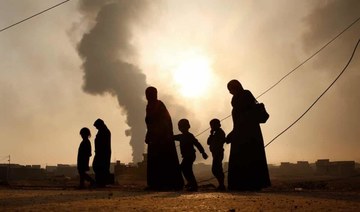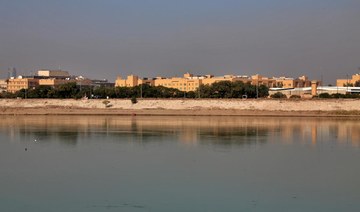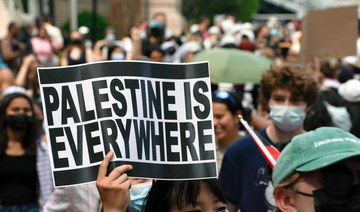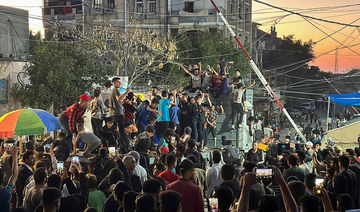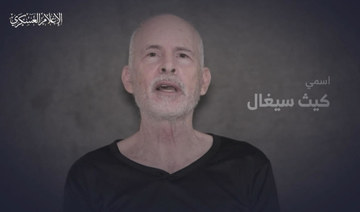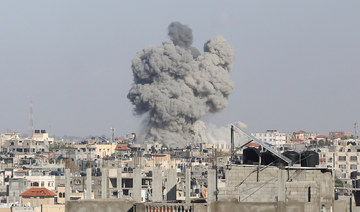BAGHDAD: Iraq is considering a larger role for NATO at the expense of the US-led coalition, Iraqi and Western officials told AFP, after an American drone strike on Baghdad that sparked outrage.
The January 3 strike which killed Iranian General Qassem Soleimani and a top Iraqi commander was condemned by Baghdad as a breach of its sovereignty and of the coalition’s mandate, which focuses on fighting Daesh.
Iraq’s parliament swiftly voted in favor of ousting all foreign troops — including the 5,200 US soldiers — and the coalition’s anti-Daesh operations were indefinitely suspended.
Fearing a swift withdrawal could be destabilising, Iraqi and Western officials have begun discussing changes to the coalition’s role, according to local officials and diplomats.
“We are talking to the coalition countries — France, the UK, Canada — about a range of scenarios,” said Abdelkarim Khalaf, spokesman for Prime Minister Adel Abdel Mahdi.
“The essential thing is that no combat troops are present and our airspace is no longer used,” Khalaf told AFP.
Two Western officials said the premier had asked them to “draft some options” on a path forward for the coalition.
These options had been submitted directly to the premier.
They included a coalition not led by the US, an amended mandate with limits to coalition activities or an expanded role for NATO’s separate mission in Iraq.
The Canadian-led NATO mission was set up in 2018 and has around 500 forces training Iraqi troops, although its operations have also been on hold since the US strike.
By comparison, the US-led coalition established in 2014 has up to 8,000 troops in Iraq, the bulk of them American forces.
Khalaf told AFP that a larger role for NATO was one of several options being discussed.
One of the Western officials said “the NATO option” has won initial nods of approval from the prime minister, the military and even anti-US elements of the powerful Hashed Al-Shaabi military network.
“I expect it will end with some sort of compromise — a smaller presence under a different title,” he said.
“The Americans will still be able to fight IS and the Iraqis can claim they kicked (the US) out.”
The various options are expected to be laid out at a meeting Wednesday between Iraq and NATO in Amman and again next month by NATO’s defense ministers.
“But there is recognition among the Europeans that there needs to be US buy-in to whatever happens next,” the Western official said.
Following parliament’s vote, Abdel Mahdi invited the US to send a delegation to Baghdad to discuss a withdrawal, but the State Department declined.
US President Donald Trump himself has said he wants NATO to play a larger role in the region.
His special envoy to the coalition, James Jeffrey, hinted at a shift last week although he said talks were in “a very early stage.”
“So there may be a shift between — at some point, hypothetically — between the number of forces under the NATO rubric and the number of forces under the coalition,” he told reporters on January 23.
NATO, whose mandate in Iraq is renewed yearly, has insisted any broader role would only involve training and an official from the alliance said there was “no discussion” of a combat role.
“There have been discussions between allies, and a lot of contact between NATO and the government of Iraq in the last couple of weeks,” a NATO official told AFP.
Since Iraq declared Daesh defeated in late 2017, coalition forces have focused on conducting air strikes and surveillance to rout militant sleeper cells.
Beginning last year, the coalition prepared plans for a troop drawdown in Iraq, two senior US defense officials said, adding that a smaller footprint would “absolutely” still be able to keep pressure on Daesh.
It was forced to “speed up that plan” in the wake of escalating Iran-US tensions, one of the officials said.
Since October, nearly 20 rocket attacks have targeted the US embassy in Baghdad or Iraqi bases hosting American forces, killing one US contractor and an Iraqi soldier.
While no one has claimed responsibility, Washington has blamed Iran-aligned factions.
Both the coalition and NATO paused operations and pulled hundreds of personnel from bases across Iraq earlier this month.
Iraqi forces have filled the gap left by the force relocation, conducting surveillance missions and air strikes on their own after years of the coalition taking the lead.
“It’s a de facto downsizing. It’s a trial run,” the first US official said.
“That’s ultimately what we’ve been striving for. We’re looking at what it would be like if we weren’t here.”
Iraq weighs larger NATO role to replace US-led coalition
https://arab.news/ce343
Iraq weighs larger NATO role to replace US-led coalition
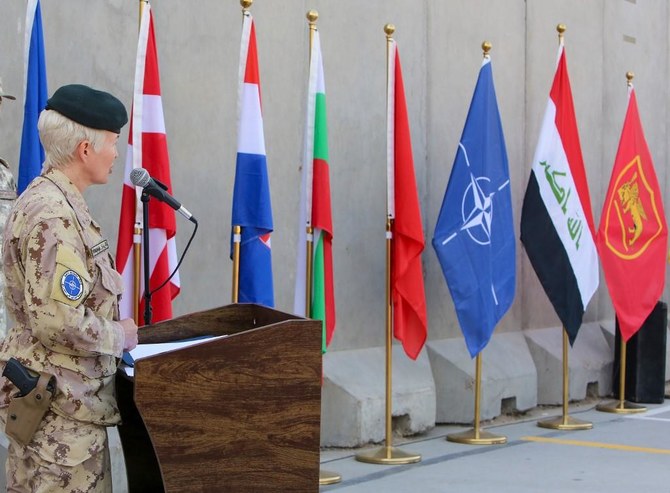
- Iraq’s parliament voted in favor of ousting all foreign troops
- The Canadian-led NATO mission was set up in 2018 and has around 500 forces training Iraqi troops
Erdogan opens former church to Muslim worshippers
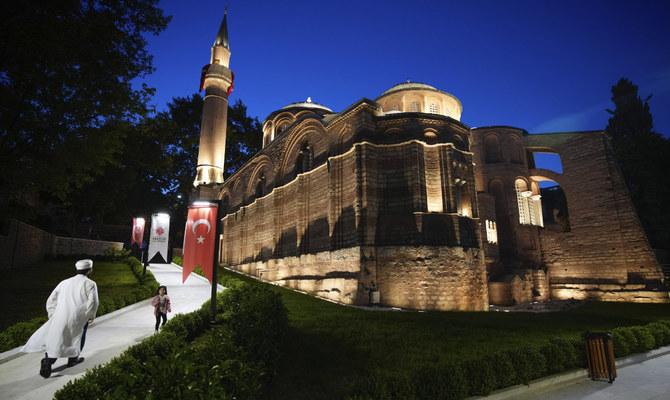
- Erdogan on Monday declared Kariye Mosque reopened for worship, remotely during a ceremony at the presidential palace in the capital, Ankara
ISTANBUL: Turkiye on Monday reopened a mosque converted from an ancient Orthodox church in Istanbul for Muslim worship, four years after the president ordered its transformation.
The Kariye Mosque was formerly a Byzantine church, then a mosque and then a museum.
President Recep Tayyip Erdogan, in 2020, ordered the building to be reconverted into a Muslim place of worship.
His order came followed a similarly controversial ruling on the UNESCO-protected Hagia Sophia — a cathedral in Istanbul that was converted into a mosque and then a museum, before becoming a mosque again.
The changes were seen as part of Erdogan’s efforts to galvanize his more conservative and nationalist supporters.
But they have also added to tensions with prelates in both the Orthodox and Catholic churches.
Erdogan on Monday declared Kariye Mosque reopened for worship, remotely during a ceremony at the presidential palace in the capital, Ankara.
An AFP picture from the mosque showed one worshipper wave a Turkish flag before the congregation who performed their prayers on a brick-red color carpet on Monday afternoon.
Images also revealed that two mosaics carved into the walls of the ancient church on the right and left sides of the prayer room were covered with curtains.
Most of the mosaics and frescos however remained visible to visitors.
“I had the opportunity to visit the place before and I was initially a little afraid of the work that could have been carried out,” said Michel, a French tourist, who would not give his full name.
“But ultimately we must recognize that it’s well done, that the frescos are accessible to everybody,” the 31-year-old researcher said.
Greece’s foreign affairs ministry on Monday night blasted a “provocation,” claiming that the move “alters the character” of the former church and “harms this UNESCO world heritage site that belongs to humanity.”
Neighbouring Greece had already reacted angrily to the decision in 2020 to convert the building.
The Holy Savior in Chora was a Byzantine church decorated with 14th-century frescoes of the Last Judgment that are still treasured by Christians.
The church was converted into Kariye Mosque half a century after the 1453 conquest of Constantinople by the Ottoman Turks.
It became the Kariye Museum after World War II, when Turkiye sought to create a more secular republic from the ashes of the Ottoman Empire.
A group of art historians from the United States helped restore the original church’s mosaics and they were put on public display in 1958.
Hagia Sophia — once the seat of Eastern Christianity — was also converted into a mosque by the Ottomans.
Ataturk, the founder of modern Turkiye after World War I, turned the UNESCO World Heritage site into a museum in a bid to promote religious neutrality.
Nearly 100 years later, Erdogan, whose ruling AKP party has Islamist roots, turned it back into a Muslim place of worship.
“It’s timeless, it’s something that for me is superior to Hagia Sophia,” Michel said of Kariye Mosque.
“It’s better preserved, less touristic and more intimate.”
Jordan’s King Abdullah presses Biden to avert Israel offensive in Rafah
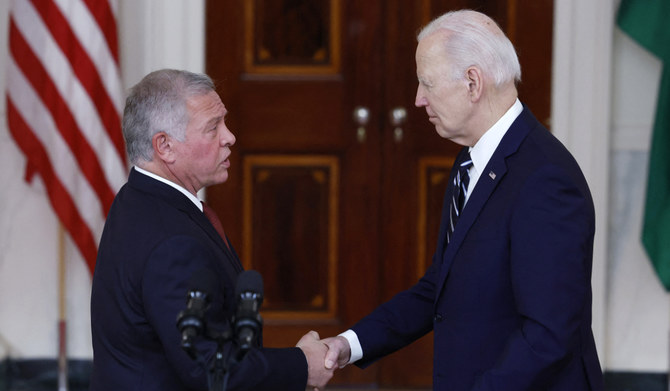
- Israel has killed more than 34,000 Palestinians, according to Gaza’s Health Ministry
- The Biden administration and Israeli officials remain at odds over Israel’s planned military incursion in the southern Gaza city of Rafah where it told Palestinians to start evacuating some parts on Monday
WASHINGTON: Jordan’s King Abdullah told US President Joe Biden in a private meeting on Monday that an Israeli offensive in Rafah would lead to a “new massacre” of Palestinian civilians and urged the international community to take urgent action.
“The king warned of the repercussions of the Israeli ground offensive on Rafah, which could cause a regional spillover of the conflict,” a statement from the Jordan royal court said after Abdullah had lunch with Biden at the White House.
Israel carried out airstrikes in Rafah on Monday and told Palestinians to evacuate parts of the city where more than a million people uprooted by the seven-month war are crowded together.
On Sunday, Hamas reiterated its demand for an end to the war in exchange for the freeing of hostages, and Israeli Prime Minister Benjamin Netanyahu flatly ruled that out. Hamas also attacked the Kerem Shalom crossing into Gaza, which Israel said killed three of its soldiers.
In a phone call on Monday with Israeli Prime Minister Benjmain Netanyahu, Biden pressed Netanyahu not to go ahead with a large-scale Israeli military offensive in Rafah. The US president has been vocal in his demand that Israel not undertake a ground offensive in Rafah without a plan to protect Palestinian civilians.
The Jordanian statement said Abdullah in his meeting with Biden “warned that the Israeli attack on Rafah, where 1.4 million Palestinians are internally displaced as a result of the war on Gaza, threatens to lead to a new massacre.”
“His Majesty stressed the importance of all efforts that seek an immediate ceasefire in Gaza,” it said. “The king and the US president affirmed their commitment to working to reach a sustainable ceasefire in Gaza, stressing the importance of facilitating the delivery of sustainable humanitarian aid to the Strip in light of the dire needs.”
The Biden administration and Israeli officials remain at odds over Israel’s planned military incursion in the southern Gaza city of Rafah where it told Palestinians to start evacuating some parts on Monday.
Biden last met King Abdullah at the White House in February and the two longtime allies discussed a daunting list of challenges, including the looming Israeli ground offensive in southern Gaza and suffering of Palestinian civilians. Jordan and other Arab states have been highly critical of Israel’s actions and have been demanding a ceasefire since mid-October as civilian casualties began to skyrocket.
The war began after Hamas stunned Israel with a cross-border raid on Oct. 7 in which 1,200 people were killed and 252 hostages taken, according to Israeli tallies.
More than 34,600 Palestinians have been killed and more than 77,000 wounded in Israel’s assault, according to Gaza’s health ministry.
What’s in the three-phase ceasefire deal Hamas backs, but Israel does not?
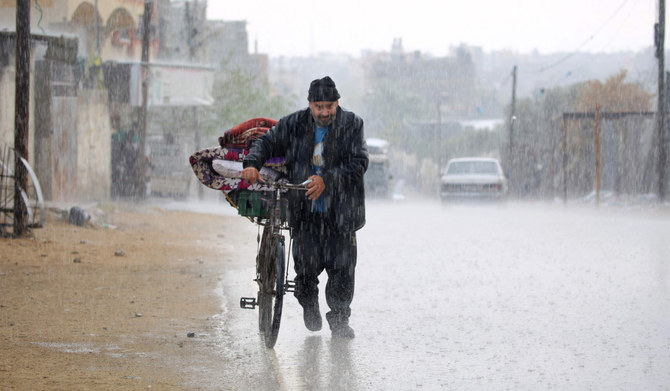
- Israel has killed more than 34,000 Palestinians, according to Gaza’s Health Ministry
CAIRO: Palestinian Islamist group Hamas said on Monday it had agreed to a three-phased deal for a ceasefire and hostages-for-prisoners swap, although an Israeli official said the deal was not acceptable to Israel because terms had been “softened.”
The United States, which alongside Qatar and Egypt has played a mediation role in the talks, said it was studying the Hamas response and would discuss it with Middle East allies.
Based on details announced so far by Hamas officials and an official briefed on the talks, the deal that the Palestinian group said it had agreed to included the following:
PHASE ONE
• 42-day ceasefire period
• Hamas releases 33 Israeli hostages in return for Israel releasing Palestinians from Israeli jails.
• Israel partially withdraws troops from Gaza and allows free movement of Palestinians from south to north Gaza.
PHASE TWO
• Another 42-day period that features an agreement to restore a “sustainable calm” to Gaza, language that an official briefed on the talks said Hamas and Israel had agreed in order to take discussion of a “permanent ceasefire” off the table.
• The complete withdrawal of most Israeli troops from Gaza.
• Hamas releases Israeli reservists and some soldiers in return for Israel releasing Palestinians from jail.
PHASE THREE
• The completion of exchanging bodies and starting the implementation of reconstruction according to the plan overseen by Qatar, Egypt and the United Nations.
• Ending the complete blockade on the Gaza Strip.
Ex-Gaza hostages in Auschwitz for March of the Living
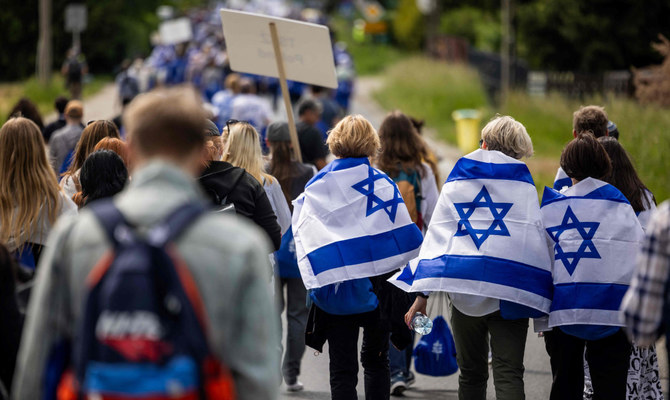
- One million European Jews died at the camp between 1940 and 1945 along with around 80,000 non-Jewish Poles, 25,000 Roma and 20,000 Soviet soldiers
OSWIECIM, Poland: Released Gaza hostages joined Holocaust survivors on Monday for an annual march in southern Poland to commemorate victims of the Auschwitz-Birkenau death camp.
Survivors of the October 7 attack on Israel by Hamas also joined the “March of the Living” at the site, which has become a symbol of Nazi Germany’s genocide of European Jews.
“I came to show that we’re alive and that we’ve built a country,” Bella Haim, 86, told AFP.
Her grandson Yotam Haim was captured by Hamas militants on October 7 and later gunned down in Gaza by Israeli soldiers who failed to realize he had escaped from his captors.
“I told myself that I couldn’t remain silent and I’m marching here in the name of my grandson Yotam and the victims” of the attack, Bella said.
She was part of an Israeli delegation that flew to Poland for the march in the southern city of Oswiecim, which numbered around 8,000 people this year.
Every year, Jews and non-Jews from around the world take part in the event at the site of the former death camp, which was built by Nazi Germany after it invaded Poland.
One million European Jews died at the camp between 1940 and 1945 along with around 80,000 non-Jewish Poles, 25,000 Roma and 20,000 Soviet soldiers.
The camp was liberated by the Red Army in January 1945.
This year’s March of the Living was briefly disrupted by pro-Palestinian protesters who spoke out against what they called Israel’s “genocide” in Gaza.
The war in Gaza broke out after Hamas’s unprecedented October 7 attack on Israel, which resulted in the deaths of more than 1,170 people, mostly civilians, according to an AFP tally of Israeli figures.
The militants also took some 250 hostages, of whom Israel estimates 128 remain in Gaza. The army says 35 of them are dead.
Vowing to destroy Hamas, Israel’s retaliatory offensive has killed at least 34,735 people in Gaza, mostly women and children, according to the Hamas-run territory’s health ministry.
Houthis ‘dismantle spy network aiding Israel, US’
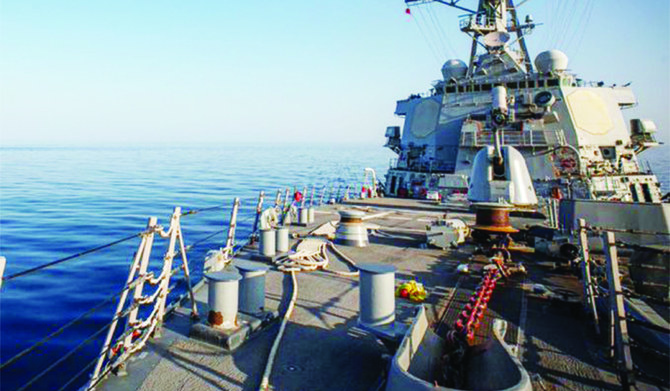
- Red Sea and the Gulf of Aden, disrupting global trade in a campaign they say is in solidarity with Palestinians amid the Israel-Hamas war
- Israel has killed more than 34,000 Palestinians in Gaza, mostly women and children, according to the health ministry in the Hamas-run territory
DUBAI: The Houthis on Monday said they had exposed a “spy” network aiding the US and Israel and arrested suspected members of it.
The Houthi-run Saba news agency published footage of the detained men, describing them as “spies recruited to collect information and monitor sites operated by the Houthi armed forces on Yemen’s western coast for the benefit of the American and Israeli enemy.”
According to Saba, the group had been recruited after the Houthis in November began targeting vessels in the Red Sea and the Gulf of Aden, disrupting global trade in a campaign they say is in solidarity with Palestinians amid the Israel-Hamas war.
The report did not specify the number of suspects arrested, but unverified images Saba shared on social media showed at least 18 people.
No evidence was provided to substantiate the charges, which Saba said the suspects had confessed to.
The Houthis, who control parts of war-torn Yemen, “will spare no effort in carrying out their responsibility to secure the home front and protect it from infiltration attempts by the American and Israeli enemy,” Saba said.
In December, the US announced a maritime security initiative to protect Red Sea shipping from Houthi attacks.
These attacks have forced commercial vessels to divert from the busy shipping lane, which normally carries 12 percent of global trade.
Since January, the US and Britain have launched repeated strikes on Houthi targets in Yemen in response to their attacks on shipping.
The Houthi-run news agency said the suspects were tasked with monitoring anti-ship missile and drone launch sites and the locations of Houthi vessels and submitting coordinates to facilitate strikes by the US as well as British forces.
The strikes have done little to deter the Houthis, who have vowed to target Israeli, American, and British vessels as well as all ships heading to Israeli ports.
On Friday, the Houthis threatened to extend their attacks into the Mediterranean Sea.



